This site uses cookies as defined in our Cookie Policy, by continuing to use this site you agree to their use.
Continue
| Arrive | Depart | ||||||
| 18th18 | AprApr | 202525 | Laem Chabang, Thailand, embark on the Viking Orion | ||||
There are two Bangkoks, the ancient soul of Thailand with its long and fascinating history and the frantic, modern metropolis that embraces the latest trends both Eastern and Western. The two blend together remarkably well—even the most jarring juxtapositions of old and new somehow make sense. Bangkok is not only the biggest city in Thailand, but also the most mesmerizing, with some of the country's most beautiful temples and shrines. The city's energy is palpable, especially at night, when traffic opens up a bit, its famous markets get going, and everything seems lit up—from its proudest monuments to its seediest streets. When Ayutthaya was besieged and pillaged by the Burmese in 1766, Thonburi became Thailand's capital. The Thais call Bangkok Krung Thep (City of Angels), and in 1782 King Rama I moved his capital here, just across the Chao Praya River. Laem Chabang is approximately 130 km (81 mi) from Bangkok. | |||||||
| 19th19 | AprApr | 202525 | Laem Chabang, Thailand | 18:00 | |||
There are two Bangkoks, the ancient soul of Thailand with its long and fascinating history and the frantic, modern metropolis that embraces the latest trends both Eastern and Western. The two blend together remarkably well—even the most jarring juxtapositions of old and new somehow make sense. Bangkok is not only the biggest city in Thailand, but also the most mesmerizing, with some of the country's most beautiful temples and shrines. The city's energy is palpable, especially at night, when traffic opens up a bit, its famous markets get going, and everything seems lit up—from its proudest monuments to its seediest streets. When Ayutthaya was besieged and pillaged by the Burmese in 1766, Thonburi became Thailand's capital. The Thais call Bangkok Krung Thep (City of Angels), and in 1782 King Rama I moved his capital here, just across the Chao Praya River. Laem Chabang is approximately 130 km (81 mi) from Bangkok. | |||||||
| 20th20 | AprApr | 202525 | Sihanoukville, Cambodia | 12:00 | |||
| 21st21 | AprApr | 202525 | Sihanoukville, Cambodia | 20:00 | |||
| 22nd22 | AprApr | 202525 | At Sea | ||||
| 23rd23 | AprApr | 202525 | Ho Chi Minh City, Vietnam | 12:00 | |||
Romantically referred to by the French as the Pearl of the Orient, Ho Chi Minh City today is a super-charged city of sensory overload. Motorbikes zoom day and night along the wide boulevards, through the narrow back alleys and past vendors pushing handcarts hawking goods of all descriptions. Still called Saigon by most residents, this is Vietnam's largest city and the engine driving the country's current economic resurgence, but despite its frenetic pace, it's a friendlier place than Hanoi and locals will tell you the food—simple, tasty, and incorporating many fresh herbs—is infinitely better than in the capital.This is a city full of surprises. The madness of the city's traffic—witness the oddball things that are transported on the back of motorcycles—is countered by tranquil pagodas, peaceful parks, quirky coffee shops, and whole neighborhoods hidden down tiny alleyways, although some of these quiet spots can be difficult to track down. Life in Ho Chi Minh City is lived in public: on the back of motorcycles, on the sidewalks, and in the parks. Even when its residents are at home, they're still on display. With many living rooms opening onto the street, grandmothers napping, babies being rocked, and food being prepared, are all in full view of passersby.Icons of the past endure in the midst of the city’s headlong rush into capitalism. The Hotel Continental, immortalized in Graham Greene's The Quiet American, continues to stand on the corner of old Indochina's most famous thoroughfare, the rue Catinat, known to American G.I.s during the Vietnam War as Tu Do (Freedom) Street and renamed Dong Khoi (Uprising) Street by the Communists. The city still has its ornate opera house and its old French city hall, the Hôtel de Ville. The broad colonial boulevards leading to the Saigon River and the gracious stucco villas are other remnants of the French colonial presence. Grisly reminders of the more recent past can be seen at the city's war-related museums. Residents, however, prefer to look forward rather than back and are often perplexed by tourists' fascination with a war that ended 40 years ago.The Chinese influence on the country is still very much in evidence in the Cholon district, the city's Chinatown, but the modern office towers and international hotels that mark the skyline symbolize Vietnam's fixation on the future. | |||||||
| 24th24 | AprApr | 202525 | Ho Chi Minh City, Vietnam | ||||
Romantically referred to by the French as the Pearl of the Orient, Ho Chi Minh City today is a super-charged city of sensory overload. Motorbikes zoom day and night along the wide boulevards, through the narrow back alleys and past vendors pushing handcarts hawking goods of all descriptions. Still called Saigon by most residents, this is Vietnam's largest city and the engine driving the country's current economic resurgence, but despite its frenetic pace, it's a friendlier place than Hanoi and locals will tell you the food—simple, tasty, and incorporating many fresh herbs—is infinitely better than in the capital.This is a city full of surprises. The madness of the city's traffic—witness the oddball things that are transported on the back of motorcycles—is countered by tranquil pagodas, peaceful parks, quirky coffee shops, and whole neighborhoods hidden down tiny alleyways, although some of these quiet spots can be difficult to track down. Life in Ho Chi Minh City is lived in public: on the back of motorcycles, on the sidewalks, and in the parks. Even when its residents are at home, they're still on display. With many living rooms opening onto the street, grandmothers napping, babies being rocked, and food being prepared, are all in full view of passersby.Icons of the past endure in the midst of the city’s headlong rush into capitalism. The Hotel Continental, immortalized in Graham Greene's The Quiet American, continues to stand on the corner of old Indochina's most famous thoroughfare, the rue Catinat, known to American G.I.s during the Vietnam War as Tu Do (Freedom) Street and renamed Dong Khoi (Uprising) Street by the Communists. The city still has its ornate opera house and its old French city hall, the Hôtel de Ville. The broad colonial boulevards leading to the Saigon River and the gracious stucco villas are other remnants of the French colonial presence. Grisly reminders of the more recent past can be seen at the city's war-related museums. Residents, however, prefer to look forward rather than back and are often perplexed by tourists' fascination with a war that ended 40 years ago.The Chinese influence on the country is still very much in evidence in the Cholon district, the city's Chinatown, but the modern office towers and international hotels that mark the skyline symbolize Vietnam's fixation on the future. | |||||||
| 25th25 | AprApr | 202525 | Ho Chi Minh City, Vietnam | 14:00 | |||
Romantically referred to by the French as the Pearl of the Orient, Ho Chi Minh City today is a super-charged city of sensory overload. Motorbikes zoom day and night along the wide boulevards, through the narrow back alleys and past vendors pushing handcarts hawking goods of all descriptions. Still called Saigon by most residents, this is Vietnam's largest city and the engine driving the country's current economic resurgence, but despite its frenetic pace, it's a friendlier place than Hanoi and locals will tell you the food—simple, tasty, and incorporating many fresh herbs—is infinitely better than in the capital.This is a city full of surprises. The madness of the city's traffic—witness the oddball things that are transported on the back of motorcycles—is countered by tranquil pagodas, peaceful parks, quirky coffee shops, and whole neighborhoods hidden down tiny alleyways, although some of these quiet spots can be difficult to track down. Life in Ho Chi Minh City is lived in public: on the back of motorcycles, on the sidewalks, and in the parks. Even when its residents are at home, they're still on display. With many living rooms opening onto the street, grandmothers napping, babies being rocked, and food being prepared, are all in full view of passersby.Icons of the past endure in the midst of the city’s headlong rush into capitalism. The Hotel Continental, immortalized in Graham Greene's The Quiet American, continues to stand on the corner of old Indochina's most famous thoroughfare, the rue Catinat, known to American G.I.s during the Vietnam War as Tu Do (Freedom) Street and renamed Dong Khoi (Uprising) Street by the Communists. The city still has its ornate opera house and its old French city hall, the Hôtel de Ville. The broad colonial boulevards leading to the Saigon River and the gracious stucco villas are other remnants of the French colonial presence. Grisly reminders of the more recent past can be seen at the city's war-related museums. Residents, however, prefer to look forward rather than back and are often perplexed by tourists' fascination with a war that ended 40 years ago.The Chinese influence on the country is still very much in evidence in the Cholon district, the city's Chinatown, but the modern office towers and international hotels that mark the skyline symbolize Vietnam's fixation on the future. | |||||||
| 26th26 | AprApr | 202525 | At Sea | ||||
| 27th27 | AprApr | 202525 | Chan May, Vietnam | 08:00 | 18:00 | ||
Hue (pronounced hway), bisected by the Perfume River and 13 km (8 mi) inland from the South China Sea, in the foothills of the Annamite Mountains (Truong Son Mountains), stands as a reminder of Vietnam's imperial past. The seat of 13 Nguyen-dynasty emperors between 1802 and 1945, Hue was once Vietnam's splendid Imperial City. Although it was devastated by the French in the 19th century and again by fighting between the Vietnamese Communists and the Americans in the 20th, the monument-speckled former capital has a war-ravaged beauty. One can still imagine its former splendor, despite gaping holes in its silhouette. Hue is a UNESCO World Heritage Site, and the city's gems are slowly being restored. | |||||||
| 28th28 | AprApr | 202525 | Ha Long Bay, Vietnam | 12:00 | |||
A visit to the north is not complete without a trip to Halong Bay, where placid waters give way to more than 3,000 limestone karsts and wind-sculpted limestone formations that jut from foggy lagoons. Dotting the bay are tiny islands bordered by white sandy coves and hidden caves, adding to the majestic landscape of this UNESCO World Heritage Site. Adding to this naturalist’s dream is the biodiversity of islets, grottos, and Cat Ba Island National Park. The bay, however, shows tourism’s impact: the clearing of mangrove forests to make way for jetties and piers, marine life threatened by game fishing, and garbage from passenger boats and fishing villages washed up on the shores.Beyond its geological uniqueness are activities like hiking, kayaking, rock climbing, or exploring one of the many floating villages where fishermen bring in their daily catch. The downside to all this allure is the large number of unlicensed boats it draws to the bay each day.Boat trips out onto the bay are the main tourism stock in trade farther north, but a more multifaceted side of the area can be experienced at Cat Ba Island. The largest island in Halong Bay, Cat Ba is very much its own entity. Its national park offers incredible biodiversity, with more than a thousand species of plants having been recorded here. Animal life is slightly thinner on the ground, but alert visitors may spy inhabitants such as the endangered golden-headed langur, wild boar, deer, civets, and several species of squirrel. Trekking through the wilderness is a highlight with a number of fascinating trails to follow.Cat Ba Island has also become a firm favorite with the adventure sports set. Indeed, along with Railay Beach in Thailand, it is recognized as one of the top spots in the region for rock climbing. Other outdoor pursuits include sailing and kayaking around the karsts. Although Halong Bay has arguably been tainted by over-exposure, Bai Tu Long Bay farther east toward China, retains all the majesty of Vietnam’s premier bucket-list natural attraction but sees a fraction of the traffic of its immediate neighbor to the west. Here, visitors will find islands of substantial size with deserted beaches and untamed jungle. Halong Bay's 3,000 islands of dolomite and limestone cover a 1,500-square-km (580-square-mile) area, extending across the Gulf of Tonkin nearly to the Chinese border. According to legend, this breathtaking land- and seascape was formed by a giant dragon that came barreling out of the mountains toward the ocean—hence the name (Halong translates into "descent of the dragon"). Geologists are more likely to attribute the formations to sedimentary limestone that formed here between 300 and 500 million years ago, in the Paleozoic Era. Over millions of years water receded and exposed the limestone to wind, rain, and tidal erosion.Today the limestone formations are exposed to hordes of tourists—but don't let that discourage you. Hundreds of fishing trawlers and tour boats share space on these crystal waters, yet there seems to be room for everyone. Most people use the main population center, Halong City, as a base from which to venture into the bay. Although it's now officially one municipality, Halong City was, until 1996, two separate towns: Bai Chay is now Halong City West, where Halong Road winds its way around the coast and past the lifeless central beach; Hon Gai is the grimier Halong City East, where a coal transportation depot dominates the center of town and covers nearby roads and buildings with a sooty film. Locals still refer to the towns by their old names, but they are now inexorably lassoed together by a bridge. Boat trips through Halong Bay are the main attraction. Little of the majesty of this region can be found in the city, so head out onto the water and start exploring. Countless 10- and 30-foot fishing boats have been converted into Halong Bay's formidable tourist-boat fleet. Hotels or travel agencies in Halong City or Hanoi can arrange boat trips for you (often they are part of organized tours from Hanoi). It is still possible to go down to the wharf and bargain yourself onto a boat for the day, but you are likely to be charged (sometimes significantly) more than you would pay for a prebooked tour, so this is not advised. Self-sufficient travelers have fallen victim to the old bait-and-switch: they've arranged a next-day boat tour with local fishermen, only to be told in no uncertain terms the following morning that they could not board their chosen boat, but they could take a different one for quite a bit more money. You may have no choice in the end. Usually travel agencies, however, have their tried-and-true favorites. | |||||||
| 29th29 | AprApr | 202525 | Ha Long Bay, Vietnam | 18:00 | |||
A visit to the north is not complete without a trip to Halong Bay, where placid waters give way to more than 3,000 limestone karsts and wind-sculpted limestone formations that jut from foggy lagoons. Dotting the bay are tiny islands bordered by white sandy coves and hidden caves, adding to the majestic landscape of this UNESCO World Heritage Site. Adding to this naturalist’s dream is the biodiversity of islets, grottos, and Cat Ba Island National Park. The bay, however, shows tourism’s impact: the clearing of mangrove forests to make way for jetties and piers, marine life threatened by game fishing, and garbage from passenger boats and fishing villages washed up on the shores.Beyond its geological uniqueness are activities like hiking, kayaking, rock climbing, or exploring one of the many floating villages where fishermen bring in their daily catch. The downside to all this allure is the large number of unlicensed boats it draws to the bay each day.Boat trips out onto the bay are the main tourism stock in trade farther north, but a more multifaceted side of the area can be experienced at Cat Ba Island. The largest island in Halong Bay, Cat Ba is very much its own entity. Its national park offers incredible biodiversity, with more than a thousand species of plants having been recorded here. Animal life is slightly thinner on the ground, but alert visitors may spy inhabitants such as the endangered golden-headed langur, wild boar, deer, civets, and several species of squirrel. Trekking through the wilderness is a highlight with a number of fascinating trails to follow.Cat Ba Island has also become a firm favorite with the adventure sports set. Indeed, along with Railay Beach in Thailand, it is recognized as one of the top spots in the region for rock climbing. Other outdoor pursuits include sailing and kayaking around the karsts. Although Halong Bay has arguably been tainted by over-exposure, Bai Tu Long Bay farther east toward China, retains all the majesty of Vietnam’s premier bucket-list natural attraction but sees a fraction of the traffic of its immediate neighbor to the west. Here, visitors will find islands of substantial size with deserted beaches and untamed jungle. Halong Bay's 3,000 islands of dolomite and limestone cover a 1,500-square-km (580-square-mile) area, extending across the Gulf of Tonkin nearly to the Chinese border. According to legend, this breathtaking land- and seascape was formed by a giant dragon that came barreling out of the mountains toward the ocean—hence the name (Halong translates into "descent of the dragon"). Geologists are more likely to attribute the formations to sedimentary limestone that formed here between 300 and 500 million years ago, in the Paleozoic Era. Over millions of years water receded and exposed the limestone to wind, rain, and tidal erosion.Today the limestone formations are exposed to hordes of tourists—but don't let that discourage you. Hundreds of fishing trawlers and tour boats share space on these crystal waters, yet there seems to be room for everyone. Most people use the main population center, Halong City, as a base from which to venture into the bay. Although it's now officially one municipality, Halong City was, until 1996, two separate towns: Bai Chay is now Halong City West, where Halong Road winds its way around the coast and past the lifeless central beach; Hon Gai is the grimier Halong City East, where a coal transportation depot dominates the center of town and covers nearby roads and buildings with a sooty film. Locals still refer to the towns by their old names, but they are now inexorably lassoed together by a bridge. Boat trips through Halong Bay are the main attraction. Little of the majesty of this region can be found in the city, so head out onto the water and start exploring. Countless 10- and 30-foot fishing boats have been converted into Halong Bay's formidable tourist-boat fleet. Hotels or travel agencies in Halong City or Hanoi can arrange boat trips for you (often they are part of organized tours from Hanoi). It is still possible to go down to the wharf and bargain yourself onto a boat for the day, but you are likely to be charged (sometimes significantly) more than you would pay for a prebooked tour, so this is not advised. Self-sufficient travelers have fallen victim to the old bait-and-switch: they've arranged a next-day boat tour with local fishermen, only to be told in no uncertain terms the following morning that they could not board their chosen boat, but they could take a different one for quite a bit more money. You may have no choice in the end. Usually travel agencies, however, have their tried-and-true favorites. | |||||||
| 30th30 | AprApr | 202525 | At Sea | ||||
| 1st01 | MayMay | 202525 | Hong Kong, Hong Kong | 08:00 | |||
The Hong Kong Island skyline, with its ever-growing number of skyscrapers, speaks to ambition and money. Paris, London, even New York were centuries in the making, while Hong Kong's towers, bright lights, and glitzy shopping emporia weren't yet part of the urban scene when many of the young investment bankers who fuel one of the world's leading financial centers were born. Commerce is concentrated in the glittering high-rises of Central, tucked between Victoria Harbor and forested peaks on Hong Kong Island's north shore. While it's easy to think all the bright lights are the sum of today's Hong Kong, you need only walk or board a tram for the short jaunt west into Western to discover a side of Hong Kong that is more traditionally Chinese but no less high-energy. You'll discover the real Hong Kong to the east of Central, too, in Wan Chai, Causeway Bay, and beyond. Amid the residential towers are restaurants, shopping malls, bars, convention centers, a nice smattering of museums, and—depending on fate and the horse you wager on—one of Hong Kong's luckiest or unluckiest spots, the Happy Valley Racecourse. Kowloon sprawls across a generous swath of the Chinese mainland across Victoria Harbour from Central. Tsim Sha Tsui, at the tip of Kowloon peninsula, is packed with glitzy shops, first-rate museums, and eye-popping views of the skyline across the water. Just to the north are the teeming market streets of Mong Kok and in the dense residential neighborhoods beyond, two of Hong Kong's most enchanting spiritual sights, Wong Tai Sin Temple and Chi Lin Nunnery. As you navigate this huge metropolis (easy to do on the excellent transportation network), keep in mind that streets are usually numbered odd on one side, even on the other. There's no baseline for street numbers and no block-based numbering system, but street signs indicate building numbers for any given block. | |||||||
| 2nd02 | MayMay | 202525 | Hong Kong, Hong Kong | ||||
The Hong Kong Island skyline, with its ever-growing number of skyscrapers, speaks to ambition and money. Paris, London, even New York were centuries in the making, while Hong Kong's towers, bright lights, and glitzy shopping emporia weren't yet part of the urban scene when many of the young investment bankers who fuel one of the world's leading financial centers were born. Commerce is concentrated in the glittering high-rises of Central, tucked between Victoria Harbor and forested peaks on Hong Kong Island's north shore. While it's easy to think all the bright lights are the sum of today's Hong Kong, you need only walk or board a tram for the short jaunt west into Western to discover a side of Hong Kong that is more traditionally Chinese but no less high-energy. You'll discover the real Hong Kong to the east of Central, too, in Wan Chai, Causeway Bay, and beyond. Amid the residential towers are restaurants, shopping malls, bars, convention centers, a nice smattering of museums, and—depending on fate and the horse you wager on—one of Hong Kong's luckiest or unluckiest spots, the Happy Valley Racecourse. Kowloon sprawls across a generous swath of the Chinese mainland across Victoria Harbour from Central. Tsim Sha Tsui, at the tip of Kowloon peninsula, is packed with glitzy shops, first-rate museums, and eye-popping views of the skyline across the water. Just to the north are the teeming market streets of Mong Kok and in the dense residential neighborhoods beyond, two of Hong Kong's most enchanting spiritual sights, Wong Tai Sin Temple and Chi Lin Nunnery. As you navigate this huge metropolis (easy to do on the excellent transportation network), keep in mind that streets are usually numbered odd on one side, even on the other. There's no baseline for street numbers and no block-based numbering system, but street signs indicate building numbers for any given block. | |||||||
| 3rd03 | MayMay | 202525 | Hong Kong, Hong Kong | 23:00 | |||
The Hong Kong Island skyline, with its ever-growing number of skyscrapers, speaks to ambition and money. Paris, London, even New York were centuries in the making, while Hong Kong's towers, bright lights, and glitzy shopping emporia weren't yet part of the urban scene when many of the young investment bankers who fuel one of the world's leading financial centers were born. Commerce is concentrated in the glittering high-rises of Central, tucked between Victoria Harbor and forested peaks on Hong Kong Island's north shore. While it's easy to think all the bright lights are the sum of today's Hong Kong, you need only walk or board a tram for the short jaunt west into Western to discover a side of Hong Kong that is more traditionally Chinese but no less high-energy. You'll discover the real Hong Kong to the east of Central, too, in Wan Chai, Causeway Bay, and beyond. Amid the residential towers are restaurants, shopping malls, bars, convention centers, a nice smattering of museums, and—depending on fate and the horse you wager on—one of Hong Kong's luckiest or unluckiest spots, the Happy Valley Racecourse. Kowloon sprawls across a generous swath of the Chinese mainland across Victoria Harbour from Central. Tsim Sha Tsui, at the tip of Kowloon peninsula, is packed with glitzy shops, first-rate museums, and eye-popping views of the skyline across the water. Just to the north are the teeming market streets of Mong Kok and in the dense residential neighborhoods beyond, two of Hong Kong's most enchanting spiritual sights, Wong Tai Sin Temple and Chi Lin Nunnery. As you navigate this huge metropolis (easy to do on the excellent transportation network), keep in mind that streets are usually numbered odd on one side, even on the other. There's no baseline for street numbers and no block-based numbering system, but street signs indicate building numbers for any given block. | |||||||
| 4th04 | MayMay | 202525 | At Sea | ||||
| 5th05 | MayMay | 202525 | Keelung (Chilung), Taiwan | 08:00 | 16:00 | ||
With the glittering lights of Taipei - a futuristic metropolis of culture and ideas - sparkling nearby, Keelung is the first calling point for many visitors arriving in Taiwan. While this port city essentially serves as Taipei's ocean gateway, you shouldn’t be too hasty in dashing off to Taipei's neon-lit magic – first it’s well worth spending some time exploring the famous glowing night market, which hums with life each evening and is famous for its local seafood. | |||||||
| 6th06 | MayMay | 202525 | At Sea | ||||
| 7th07 | MayMay | 202525 | Nagasaki, Japan | 08:00 | 18:00 | ||
Nagasaki city has developed into one of the most important port cities in Japan. During Japan’s period of isolation in the 17th century, Nagasaki played a prominent role in foreign trade relation and only a very few ports were open to restricted numbers of foreign traders. Even though Holland was a major country who conducted trading during this period, Dutch people were only allowed to stay in Dejima Island and were not allowed to have contact with the Japanese people. Today, you will still find the strong influence of Dutch and Chinese culture in the city which is very different from all other cities in Japan. In the more recent history, Nagasaki became the second city after Hiroshima to be destroyed by an atomic bomb towards the end of World War II. From the visit to Atomic bomb museum and peace memorial park, people could understand how chaotic the situation was and the agony that the people in the days have experienced from the damage inflicted by the atomic bomb. It continues to appeal to the world with their wish for world peace. | |||||||
| 8th08 | MayMay | 202525 | Kagoshima, Japan | 07:00 | 17:00 | ||
Kagoshima city is the capital of Kagoshima prefecture and also Kyushu’s southernmost major city. This city is often compared to its Italian sister city Naples, due to its’s similarities such as mild climate and active volcano, Sakurajima. Sakurajima is one of the most renowned active volcanos not only in Japan but also in the whole entire world. This smoking Sakurajima is centred in Kinko Bay and is one of the main symbols of this prefecture. We cannot talk about Sakurajima without the history of continuous eruption. Sakurajima used to be an isolated island; however, the land has banded together with Osumi peninsula from the eruption in 1914. You may have a chance to see the smoke coming from the top of Sakurajima depending on the weather condition. Not only does the scenery of Sakurajima represent the beauty of Kagoshima City but Senganen garden is also symbolic to elegance in the Kagoshima region. This Japanese garden was constructed by a feudal lord, Mitsuhisa Shimazu, as a guest house of the Kagoshima castle which attracts many visitors for its splendid view. | |||||||
| 9th09 | MayMay | 202525 | Beppu, Kyushu Island, Oita, Japan | 09:30 | 22:00 | ||
| 10th10 | MayMay | 202525 | Hiroshima, Japan | 08:00 | |||
History buffs will want to write home Hiroshima. Despite being devastated in 1945, this Japanese city is known to all for its commitment peace – its ruin on the 6th August 1945 led to the end of the war and today, the Peace Memorial (a UNESCO World Heritage Site) , is a constant reminder of the destruction that war brings. A walk in the leafy boulevards of Peace Memorial Park brings quiet contemplation. The Flames of Peace – set in the park’s central feature pond – burn brightly and will continue to do so until all the nuclear bombs I the world have been destroyed. There are many other inspiring messages of hope around the city too; the Children’s’ Peace Monument just north of the park is a homage to little Sadako Sasaki, who was just two in 1945. When she developed leukemia in 1956, she believed that if she folded 1,000 paper cranes – a symbol of longevity and happiness in Japan – she would recover. Sadly she died before she finished her task but her classmates finished the rest. It is impossible to ignore the events of 1945 in Hiroshima, but this is far from a depressing place. The great efforts that have been made in rebuilding of the city over the years have given Hiroshima a vibrant, eclectic edge, with the downtown shopping area and street food stalls being well worth a visit. The proximity to Miyajima and its iconic, impressive, Torii gate should not be overlooked either. If you are lucky enough to visit during the unpredictable and short-lived Sakura (cherry blossom) season, then the extraordinary sight of the delicate pink blossom floating across the water to the red gate, means you can consider yourself one of the luckiest people on the planet. | |||||||
| 11th11 | MayMay | 202525 | Hiroshima, Japan | 12:00 | |||
History buffs will want to write home Hiroshima. Despite being devastated in 1945, this Japanese city is known to all for its commitment peace – its ruin on the 6th August 1945 led to the end of the war and today, the Peace Memorial (a UNESCO World Heritage Site) , is a constant reminder of the destruction that war brings. A walk in the leafy boulevards of Peace Memorial Park brings quiet contemplation. The Flames of Peace – set in the park’s central feature pond – burn brightly and will continue to do so until all the nuclear bombs I the world have been destroyed. There are many other inspiring messages of hope around the city too; the Children’s’ Peace Monument just north of the park is a homage to little Sadako Sasaki, who was just two in 1945. When she developed leukemia in 1956, she believed that if she folded 1,000 paper cranes – a symbol of longevity and happiness in Japan – she would recover. Sadly she died before she finished her task but her classmates finished the rest. It is impossible to ignore the events of 1945 in Hiroshima, but this is far from a depressing place. The great efforts that have been made in rebuilding of the city over the years have given Hiroshima a vibrant, eclectic edge, with the downtown shopping area and street food stalls being well worth a visit. The proximity to Miyajima and its iconic, impressive, Torii gate should not be overlooked either. If you are lucky enough to visit during the unpredictable and short-lived Sakura (cherry blossom) season, then the extraordinary sight of the delicate pink blossom floating across the water to the red gate, means you can consider yourself one of the luckiest people on the planet. | |||||||
| 12th12 | MayMay | 202525 | Osaka, Japan | 09:00 | 20:00 | ||
From Minami's neon-lighted Dotombori and historic Tenno-ji to the high-rise class and underground shopping labyrinths of Kita, Osaka is a city that pulses with its own unique rhythm. Though Osaka has no shortage of tourist sites, it is the city itself that is the greatest attraction. Home to some of Japan's best food, most unique fashions, and warmest locals, Osaka does not beg to be explored—it demands it. More than anywhere else in Japan, it rewards the impulsive turn down an interesting side street or the chat with a random stranger. People do not come here to see the city, they come to experience it.Excluded from the formal circles of power and aristocratic culture in 16th-century Edo (Tokyo), Osaka took advantage of its position as Japan's trading center, developing its own art forms such as Bunraku puppet theater and Rakugo comic storytelling. It was in Osaka that feudal Japan's famed Floating World—the dining, theater, and pleasure district—was at its strongest and most inventive. Wealthy merchants and common laborers alike squandered fortunes on culinary delights, turning Osaka into "Japan's Kitchen," a moniker the city still has today. Though the city suffered a blow when the Meiji government canceled all of the samurai class's outstanding debts to the merchants, it was quick to recover. At the turn of the 20th century, it had become Japan's largest and most prosperous city, a center of commerce and manufacturing.Today Osaka remains Japan's iconoclastic metropolis, refusing to fit Tokyo's norms and expectations. Unlike the hordes of Tokyo, Osakans are fiercely independent. As a contrast to the neon and concrete surroundings, the people of Osaka are known as Japan's friendliest and most outgoing. Ask someone on the street for directions in Tokyo and you are lucky to get so much as a glance. Ask someone in Osaka and you get a conversation.The main areas of the city, Kita (north) and Minami (south), are divided by two rivers: the Dojima-gawa and the Tosabori-gawa. Between Kita and Minami is Naka-no-shima, an island and the municipal center of Osaka. Kita (north of Chuo Dori) is Osaka's economic hub and contains Osaka's largest stations: JR Osaka and Hankyu Umeda. The area is crammed with shops, department stores, and restaurants. Nearby are a nightlife district, Kita-shinchi; Naka-no-shima and the Museum of Oriental Ceramics; Osaka-jo (Osaka Castle); and Osaka Koen (Osaka Park). Restaurants, bars, department stores, and boutiques attract Osaka's youth to Minami (south Chuo Dori); theatergoers head to the National Bunraku Theatre and electronics-lovers to Den Den Town. For a glimpse of old Osaka, visit Tenno-ji Temple and Shin Sekai. The main stations are Namba, Shin-sai-bashi, Namba Nankai, and Tenno-ji. There's easy access to the Municipal Museum of Fine Art and Sumiyoshi Taisha (Sumiyoshi Grand Shrine).The bay area, to the west of the city center, is home to the Osaka Aquarium and Universal Studios Japan. The Shinkansen stops at Shin-Osaka, three stops (about five minutes) north of Osaka Station on the Mido-suji subway line. To the north of Shin-Osaka is Senri Expo Park. | |||||||
| 13th13 | MayMay | 202525 | Shimizu, Japan | 18:00 | |||
The salt and pepper cone of Japan's most famous natural landmark won’t fail to take your breath away, as it soars into the sky in a vision of spectacular symmetry. Make sure your camera is fully prepared before you dock in Shimizu’s port, where unparalleled views of the extraordinary Mount Fuji’s dramatic peak await. Take your time to soak up one of Japan's most iconic views, before dipping your toes into the rest of what this destination of tranquil temples has to offer. While there’s a bustling fish market, and a charming amusement park waiting close to the port, most new arrivals immediately set off in pursuit of the best views of Mount Fuji, or to see the stunning panorama on offer from the heights of the Kunozan Toshogu Shrine. Take the cable car up to the top, to experience the tranquillity around the forested shrine, and to enjoy its stunning architecture of deep scarlets and gleaming golds. You can also enjoy heart-stopping views out over the Bay of Suruga, and the tea plantations below. | |||||||
| 14th14 | MayMay | 202525 | Shimizu, Japan | 18:00 | |||
The salt and pepper cone of Japan's most famous natural landmark won’t fail to take your breath away, as it soars into the sky in a vision of spectacular symmetry. Make sure your camera is fully prepared before you dock in Shimizu’s port, where unparalleled views of the extraordinary Mount Fuji’s dramatic peak await. Take your time to soak up one of Japan's most iconic views, before dipping your toes into the rest of what this destination of tranquil temples has to offer. While there’s a bustling fish market, and a charming amusement park waiting close to the port, most new arrivals immediately set off in pursuit of the best views of Mount Fuji, or to see the stunning panorama on offer from the heights of the Kunozan Toshogu Shrine. Take the cable car up to the top, to experience the tranquillity around the forested shrine, and to enjoy its stunning architecture of deep scarlets and gleaming golds. You can also enjoy heart-stopping views out over the Bay of Suruga, and the tea plantations below. | |||||||
| 15th15 | MayMay | 202525 | Tokyo, Japan | 08:00 | |||
Lights, sushi, manga! Sprawling, frenetic, and endlessly fascinating, Japan’s capital is a city of contrasts. Shrines and gardens are pockets of calm between famously crowded streets and soaring office buildings. Mom-and-pop noodle houses share street space with Western-style chain restaurants and exquisite fine dining. Shopping yields lovely folk arts as well as the newest electronics. And nightlife kicks off with karaoke or sake and continues with techno clubs and more. Whether you seek the traditional or the cutting edge, Tokyo will provide it. | |||||||
| 16th16 | MayMay | 202525 | Tokyo, Japan, disembark the Viking Orion | ||||
Lights, sushi, manga! Sprawling, frenetic, and endlessly fascinating, Japan’s capital is a city of contrasts. Shrines and gardens are pockets of calm between famously crowded streets and soaring office buildings. Mom-and-pop noodle houses share street space with Western-style chain restaurants and exquisite fine dining. Shopping yields lovely folk arts as well as the newest electronics. And nightlife kicks off with karaoke or sake and continues with techno clubs and more. Whether you seek the traditional or the cutting edge, Tokyo will provide it. | |||||||
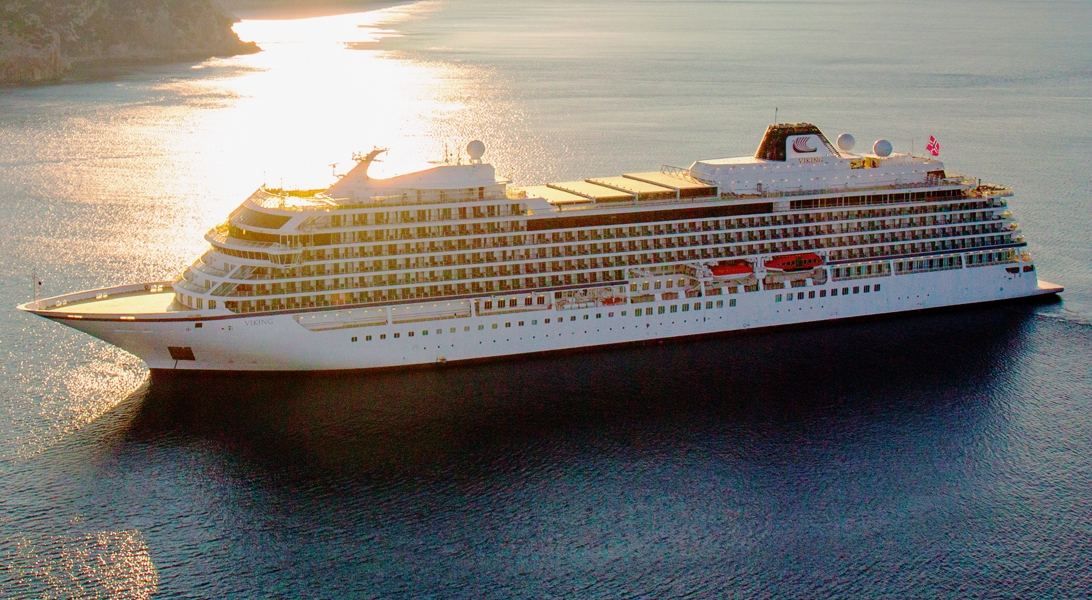










The images shown are for illustration purposes only and may not be an exact representation of what you find on the ship.
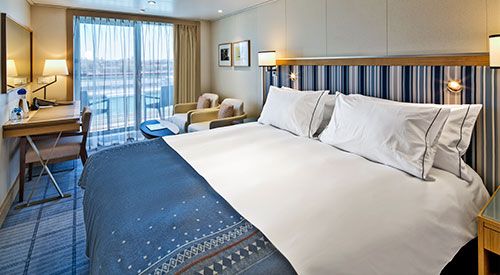
| Grade Code | From | To | |
| DV6 | Deluxe Veranda | £15,480 | £15,480 |
| DV5 | Deluxe Veranda | £15,880 | £15,880 |
| DV4 | Deluxe Veranda | £16,380 | £16,380 |
| DV3 | Deluxe Veranda | £16,780 | £16,780 |
| DV2 | Deluxe Veranda | £17,180 | £17,180 |
| DV1 | Deluxe Veranda | £17,580 | £17,580 |
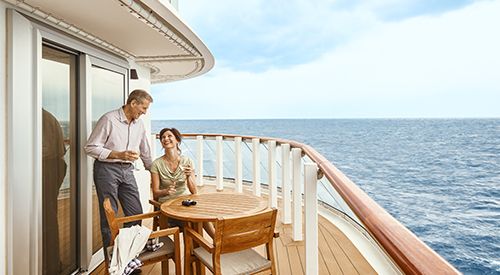
| Grade Code | From | To | |
| ES3 | Explorer Suite | £40,780 | £40,780 |
| ES2 | Explorer Suite | £42,180 | £42,180 |
| ES1 | Explorer Suite | £45,180 | £45,180 |
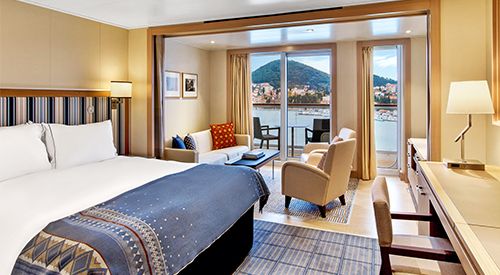
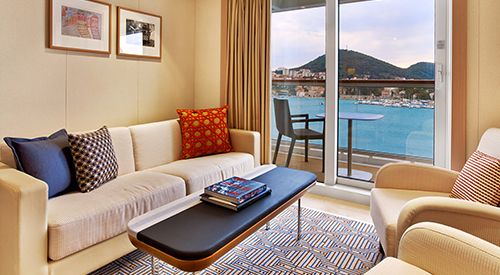
| Grade Code | From | To | |
| PS3 | Penthouse Junior Suite | £31,380 | £31,380 |
| PS2 | Penthouse Junior Suite | £32,180 | £32,180 |
| PS1 | Penthouse Junior Suite | £32,980 | £32,980 |
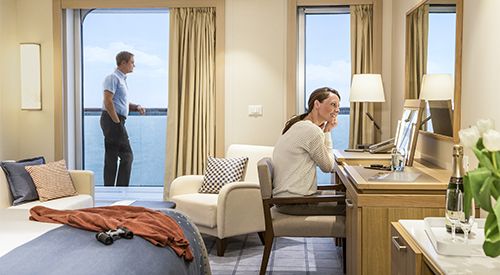
| Grade Code | From | To | |
| PV3 | Penthouse Veranda | £23,080 | £23,080 |
| PV2 | Penthouse Veranda | £23,480 | £23,480 |
| PV1 | Penthouse Veranda | £23,880 | £23,880 |

| Grade Code | From | To | |
| V2 | Veranda | £14,780 | £14,780 |
| V1 | Veranda | £15,080 | £15,080 |
The images shown are for illustration purposes only and may not be an exact representation of what you find on the ship.
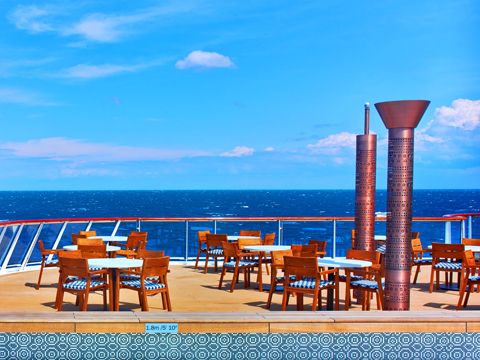
There is nothing like dining in the great outdoors. Big sky. Setting sun and a chance to drink in the fresh air, as well as the views. Step out of The World Café onto The Aquavit Terrace. Breakfast, lunch and dinner, it is everything you want relaxed dining to be.
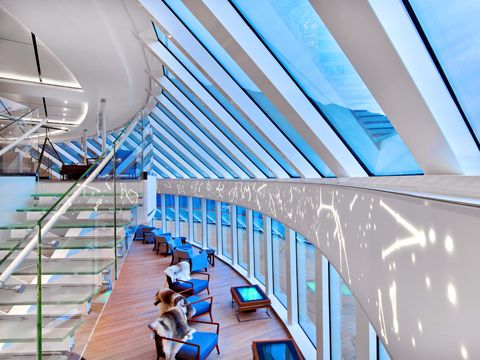
Inspired by the trade routes of Vikings, the Explorers’ Lounge is the ideal place for guests to share their discoveries over an aquavit or a craft beer while sampling fine Scandinavian fare. Central to the Explorers’ Lounge is Mamsen’s, a casual gourmet deli inspired by Norwegian cuisine, from smoked salmon to open-faced sandwiches and locally sourced charcuterie and cheeses. The daily “Waffle Hour” provides mouth-watering samples of the beloved treat.
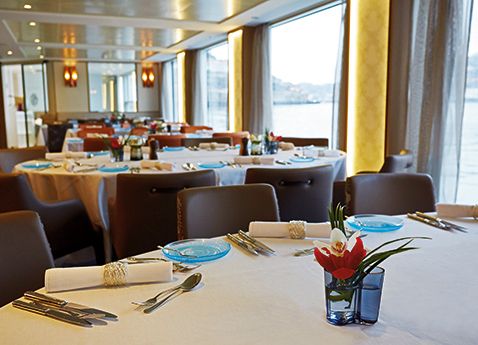
Breakfast and dinner, welcome to The Restaurant. One of the finest restaurants you'll find. Anywhere. Where the daily changing menus complement the daily changing views. And where you can feast on traditional favourites as well as local specialities, all perfectly prepared and presented.
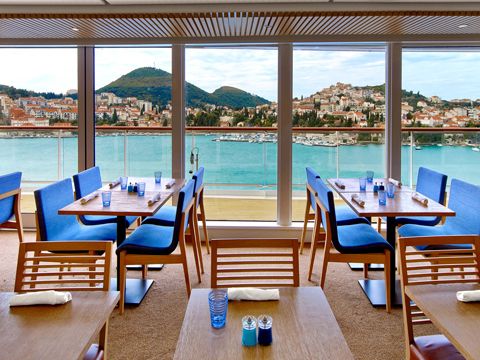
Discover flavours of the east in Copenhagen, the tastes of Tuscany in Sydney, and the freshest sushi in the Amazon jungle. Morning, noon and night, explore a world of taste at the World Cafe. A celebration of foods that make us different, but also bring us together.
The images shown are for illustration purposes only and may not be an exact representation of what you find on the ship.

Inspired by the trade routes of Vikings, the Explorers’ Lounge is the ideal place for guests to share their discoveries over an aquavit or a craft beer while sampling fine Scandinavian fare. Central to the Explorers’ Lounge is Mamsen’s, a casual gourmet deli inspired by Norwegian cuisine, from smoked salmon to open-faced sandwiches and locally sourced charcuterie and cheeses. The daily “Waffle Hour” provides mouth-watering samples of the beloved treat.
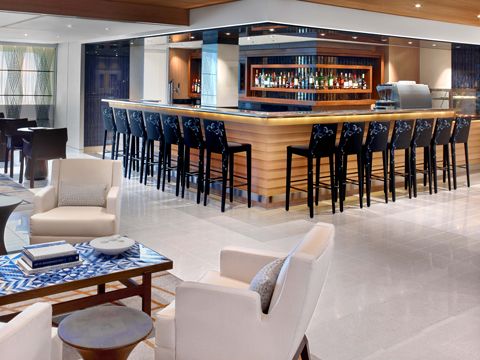
Enjoy a cocktail in the Viking Bar, which is located on the ground floor of the atrium.

The ideal setting for relaxation and conversation, The Viking Living Room draws guests together. Spacious seating, melodic piano tunes, live entertainment and planned activities foster rich camaraderie. And its well-curated Viking Library informs even the best-read traveler. Adorned with nautical touches from Viking days, including the clinker-built bar inspired by ancient longships, it is the most inspired living room at sea.
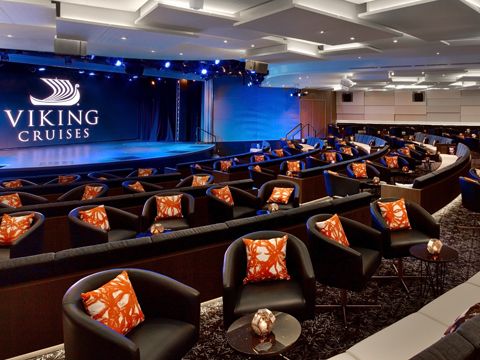
Even our theaters connect you to the destinations.
Our main venue, The Theater, features live performances that bring you closer to the culture of our destinations. Sometimes, the destination we connect you to exists solely in the realm of an otherworldly theatrical journey, as is the case with beautifully themed shows.
We will also pull back the curtains of our destinations with cinema in our two movie theaters, which show first-run films you have not yet seen as well as destination-driven cinema such as "Room with A View," "Roman Holiday," or "Skyfall." And because the intellect also needs to be stimulated, our theaters will always be buzzing with fresh, new insights from our port talks and onboard lectures that feature the history, art, and culture of our destinations. And since we have always promised you will explore the world in comfort, we have banished uncomfortable theater seating in favor of soft and spacious sofa seating

When you yearn for serenity, there is no better place on ship than a visit to the Wintergarden. This charming, airy space around the main pool is perfect for relaxing in clean, uncluttered Scandinavian-designed environment. Even here, our focus is on enrichment, as this is the place to witness a tea ceremony, or indulge in an afternoon tea service, complete with hand-selected teas, finger sandwiches and pastries.
The images shown are for illustration purposes only and may not be an exact representation of what you find on the ship.
The images shown are for illustration purposes only and may not be an exact representation of what you find on the ship.
| Return flights including luggage allowance | |||
| Overseas Transfers | |||
| 28 nights aboard the Viking Orion | |||
| Deluxe all-veranda accommodation | |||
| Wine, beer and soft drinks with all meals on-board | |||
| Enriched escorted tours with guide and headsets | |||
| Complimentary self-service laundry | |||
| Complimentary speciality restaurants | |||
| Complimentary tea and coffee | |||
| Port Taxes and Fees | |||
 | ABTA and ATOL Protection* | ||
Fly/cruise package |
Date 18th Apr 2025 |
Nts 28 |
Balcony  |
Suite £23,880pp |
Balcony  |
Suite £23,880pp |
Balcony  |
Suite £23,880pp |
Balcony  |
Suite £23,880pp |
Balcony  |
Suite £23,880pp |
Balcony  |
Suite £23,880pp |
Balcony  |
Suite £23,880pp |
Balcony  |
Suite £23,880pp |
Balcony  |
Suite £23,880pp |
Balcony  |
Suite £23,880pp |
Balcony  |
Suite £23,880pp |
Balcony  |
Suite £23,880pp |
Date 18th Apr 2025 |
Nts 28 |
Balcony  |
Suite £23,880pp |
Balcony  |
Suite £23,880pp |
Balcony  |
Suite £23,880pp |
Balcony  |
Suite £23,880pp |
Balcony  |
Suite £23,880pp |
Balcony  |
Suite £23,880pp |
Balcony  |
Suite £23,880pp |
Balcony  |
Suite £23,880pp |
Balcony  |
Suite £23,880pp |
Balcony  |
Suite £23,880pp |
Balcony  |
Suite £23,880pp |
Balcony  |
Suite £23,880pp |












| Balcony staterooms |  | ||
| DV1 | Deluxe Veranda |  | |
| DV2 | Deluxe Veranda |  | |
| DV3 | Deluxe Veranda |  | |
| DV4 | Deluxe Veranda |  | |
| DV5 | Deluxe Veranda |  | |
| DV6 | Deluxe Veranda |  | |
| V1 | Veranda |  | |
| V2 | Veranda |  | |
| Suite staterooms from | £23,880pp | ||
| OS | Owner's Suite |  | |
| ES1 | Explorer Suite |  | |
| ES2 | Explorer Suite |  | |
| ES3 | Explorer Suite |  | |
| PS1 | Penthouse Junior Suite |  | |
| PS2 | Penthouse Junior Suite | £32,180pp | |
| PS3 | Penthouse Junior Suite | £31,380pp | |
| PV1 | Penthouse Veranda | £23,880pp | |
| PV3 | Penthouse Veranda |  | |
| PV2 | Penthouse Veranda |  | |
| Balcony staterooms |  | ||
| DV1 | Deluxe Veranda |  | |
| DV2 | Deluxe Veranda |  | |
| DV3 | Deluxe Veranda |  | |
| DV4 | Deluxe Veranda |  | |
| DV5 | Deluxe Veranda |  | |
| DV6 | Deluxe Veranda |  | |
| V1 | Veranda |  | |
| V2 | Veranda |  | |
| Suite staterooms from | £23,880pp | ||
| OS | Owner's Suite |  | |
| ES1 | Explorer Suite |  | |
| ES2 | Explorer Suite |  | |
| ES3 | Explorer Suite |  | |
| PS1 | Penthouse Junior Suite |  | |
| PS2 | Penthouse Junior Suite | £32,180pp | |
| PS3 | Penthouse Junior Suite | £31,380pp | |
| PV1 | Penthouse Veranda | £23,880pp | |
| PV3 | Penthouse Veranda |  | |
| PV2 | Penthouse Veranda |  | |
| Balcony staterooms |  | ||
| DV1 | Deluxe Veranda |  | |
| DV2 | Deluxe Veranda |  | |
| DV3 | Deluxe Veranda |  | |
| DV4 | Deluxe Veranda |  | |
| DV5 | Deluxe Veranda |  | |
| DV6 | Deluxe Veranda |  | |
| V1 | Veranda |  | |
| V2 | Veranda |  | |
| Suite staterooms from | £23,880pp | ||
| OS | Owner's Suite |  | |
| ES1 | Explorer Suite |  | |
| ES2 | Explorer Suite |  | |
| ES3 | Explorer Suite |  | |
| PS1 | Penthouse Junior Suite |  | |
| PS2 | Penthouse Junior Suite | £32,180pp | |
| PS3 | Penthouse Junior Suite | £31,380pp | |
| PV1 | Penthouse Veranda | £23,880pp | |
| PV3 | Penthouse Veranda |  | |
| PV2 | Penthouse Veranda |  | |
| Balcony staterooms |  | ||
| DV1 | Deluxe Veranda |  | |
| DV2 | Deluxe Veranda |  | |
| DV3 | Deluxe Veranda |  | |
| DV4 | Deluxe Veranda |  | |
| DV5 | Deluxe Veranda |  | |
| DV6 | Deluxe Veranda |  | |
| V1 | Veranda |  | |
| V2 | Veranda |  | |
| Suite staterooms from | £23,880pp | ||
| OS | Owner's Suite |  | |
| ES1 | Explorer Suite |  | |
| ES2 | Explorer Suite |  | |
| ES3 | Explorer Suite |  | |
| PS1 | Penthouse Junior Suite |  | |
| PS2 | Penthouse Junior Suite | £32,180pp | |
| PS3 | Penthouse Junior Suite | £31,380pp | |
| PV1 | Penthouse Veranda | £23,880pp | |
| PV3 | Penthouse Veranda |  | |
| PV2 | Penthouse Veranda |  | |
| Balcony staterooms |  | ||
| DV1 | Deluxe Veranda |  | |
| DV2 | Deluxe Veranda |  | |
| DV3 | Deluxe Veranda |  | |
| DV4 | Deluxe Veranda |  | |
| DV5 | Deluxe Veranda |  | |
| DV6 | Deluxe Veranda |  | |
| V1 | Veranda |  | |
| V2 | Veranda |  | |
| Suite staterooms from | £23,880pp | ||
| OS | Owner's Suite |  | |
| ES1 | Explorer Suite |  | |
| ES2 | Explorer Suite |  | |
| ES3 | Explorer Suite |  | |
| PS1 | Penthouse Junior Suite |  | |
| PS2 | Penthouse Junior Suite | £32,180pp | |
| PS3 | Penthouse Junior Suite | £31,380pp | |
| PV1 | Penthouse Veranda | £23,880pp | |
| PV3 | Penthouse Veranda |  | |
| PV2 | Penthouse Veranda |  | |
| Balcony staterooms |  | ||
| DV1 | Deluxe Veranda |  | |
| DV2 | Deluxe Veranda |  | |
| DV3 | Deluxe Veranda |  | |
| DV4 | Deluxe Veranda |  | |
| DV5 | Deluxe Veranda |  | |
| DV6 | Deluxe Veranda |  | |
| V1 | Veranda |  | |
| V2 | Veranda |  | |
| Suite staterooms from | £23,880pp | ||
| OS | Owner's Suite |  | |
| ES1 | Explorer Suite |  | |
| ES2 | Explorer Suite |  | |
| ES3 | Explorer Suite |  | |
| PS1 | Penthouse Junior Suite |  | |
| PS2 | Penthouse Junior Suite | £32,180pp | |
| PS3 | Penthouse Junior Suite | £31,380pp | |
| PV1 | Penthouse Veranda | £23,880pp | |
| PV3 | Penthouse Veranda |  | |
| PV2 | Penthouse Veranda |  | |
| Balcony staterooms |  | ||
| DV1 | Deluxe Veranda |  | |
| DV2 | Deluxe Veranda |  | |
| DV3 | Deluxe Veranda |  | |
| DV4 | Deluxe Veranda |  | |
| DV5 | Deluxe Veranda |  | |
| DV6 | Deluxe Veranda |  | |
| V1 | Veranda |  | |
| V2 | Veranda |  | |
| Suite staterooms from | £23,880pp | ||
| OS | Owner's Suite |  | |
| ES1 | Explorer Suite |  | |
| ES2 | Explorer Suite |  | |
| ES3 | Explorer Suite |  | |
| PS1 | Penthouse Junior Suite |  | |
| PS2 | Penthouse Junior Suite | £32,180pp | |
| PS3 | Penthouse Junior Suite | £31,380pp | |
| PV1 | Penthouse Veranda | £23,880pp | |
| PV3 | Penthouse Veranda |  | |
| PV2 | Penthouse Veranda |  | |
| Balcony staterooms |  | ||
| DV1 | Deluxe Veranda |  | |
| DV2 | Deluxe Veranda |  | |
| DV3 | Deluxe Veranda |  | |
| DV4 | Deluxe Veranda |  | |
| DV5 | Deluxe Veranda |  | |
| DV6 | Deluxe Veranda |  | |
| V1 | Veranda |  | |
| V2 | Veranda |  | |
| Suite staterooms from | £23,880pp | ||
| OS | Owner's Suite |  | |
| ES1 | Explorer Suite |  | |
| ES2 | Explorer Suite |  | |
| ES3 | Explorer Suite |  | |
| PS1 | Penthouse Junior Suite |  | |
| PS2 | Penthouse Junior Suite | £32,180pp | |
| PS3 | Penthouse Junior Suite | £31,380pp | |
| PV1 | Penthouse Veranda | £23,880pp | |
| PV3 | Penthouse Veranda |  | |
| PV2 | Penthouse Veranda |  | |
| Balcony staterooms |  | ||
| DV1 | Deluxe Veranda |  | |
| DV2 | Deluxe Veranda |  | |
| DV3 | Deluxe Veranda |  | |
| DV4 | Deluxe Veranda |  | |
| DV5 | Deluxe Veranda |  | |
| DV6 | Deluxe Veranda |  | |
| V1 | Veranda |  | |
| V2 | Veranda |  | |
| Suite staterooms from | £23,880pp | ||
| OS | Owner's Suite |  | |
| ES1 | Explorer Suite |  | |
| ES2 | Explorer Suite |  | |
| ES3 | Explorer Suite |  | |
| PS1 | Penthouse Junior Suite |  | |
| PS2 | Penthouse Junior Suite | £32,180pp | |
| PS3 | Penthouse Junior Suite | £31,380pp | |
| PV1 | Penthouse Veranda | £23,880pp | |
| PV3 | Penthouse Veranda |  | |
| PV2 | Penthouse Veranda |  | |
| Balcony staterooms |  | ||
| DV1 | Deluxe Veranda |  | |
| DV2 | Deluxe Veranda |  | |
| DV3 | Deluxe Veranda |  | |
| DV4 | Deluxe Veranda |  | |
| DV5 | Deluxe Veranda |  | |
| DV6 | Deluxe Veranda |  | |
| V1 | Veranda |  | |
| V2 | Veranda |  | |
| Suite staterooms from | £23,880pp | ||
| OS | Owner's Suite |  | |
| ES1 | Explorer Suite |  | |
| ES2 | Explorer Suite |  | |
| ES3 | Explorer Suite |  | |
| PS1 | Penthouse Junior Suite |  | |
| PS2 | Penthouse Junior Suite | £32,180pp | |
| PS3 | Penthouse Junior Suite | £31,380pp | |
| PV1 | Penthouse Veranda | £23,880pp | |
| PV3 | Penthouse Veranda |  | |
| PV2 | Penthouse Veranda |  | |
| Balcony staterooms |  | ||
| DV1 | Deluxe Veranda |  | |
| DV2 | Deluxe Veranda |  | |
| DV3 | Deluxe Veranda |  | |
| DV4 | Deluxe Veranda |  | |
| DV5 | Deluxe Veranda |  | |
| DV6 | Deluxe Veranda |  | |
| V1 | Veranda |  | |
| V2 | Veranda |  | |
| Suite staterooms from | £23,880pp | ||
| OS | Owner's Suite |  | |
| ES1 | Explorer Suite |  | |
| ES2 | Explorer Suite |  | |
| ES3 | Explorer Suite |  | |
| PS1 | Penthouse Junior Suite |  | |
| PS2 | Penthouse Junior Suite | £32,180pp | |
| PS3 | Penthouse Junior Suite | £31,380pp | |
| PV1 | Penthouse Veranda | £23,880pp | |
| PV3 | Penthouse Veranda |  | |
| PV2 | Penthouse Veranda |  | |
| Balcony staterooms |  | ||
| DV1 | Deluxe Veranda |  | |
| DV2 | Deluxe Veranda |  | |
| DV3 | Deluxe Veranda |  | |
| DV4 | Deluxe Veranda |  | |
| DV5 | Deluxe Veranda |  | |
| DV6 | Deluxe Veranda |  | |
| V1 | Veranda |  | |
| V2 | Veranda |  | |
| Suite staterooms from | £23,880pp | ||
| OS | Owner's Suite |  | |
| ES1 | Explorer Suite |  | |
| ES2 | Explorer Suite |  | |
| ES3 | Explorer Suite |  | |
| PS1 | Penthouse Junior Suite |  | |
| PS2 | Penthouse Junior Suite | £32,180pp | |
| PS3 | Penthouse Junior Suite | £31,380pp | |
| PV1 | Penthouse Veranda | £23,880pp | |
| PV3 | Penthouse Veranda |  | |
| PV2 | Penthouse Veranda |  | |
Fusion Cruises when selling travel arrangements is a trading name of The Midcounties Co-operative Ltd. Fusion Cruises is an Accredited Body Member of Midcounties Co-operative Travel Consortium. (ABTA:P6652, ATOL:6053).
Book with Confidence. We are a Member of ABTA which means you have the benefit of ABTA’s assistance and Code of Conduct.
Some of the flights and flight-inclusive holidays on this website are financially protected by the ATOL scheme but ATOL protection does not apply to all holiday and travel services offered on this website. This website will provide you with information on the protection that applies in the case of each holiday and travel service offered before you make your booking. If you do not receive an ATOL Certificate then the booking will not be ATOL protected. If you do receive an ATOL Certificate but all parts of your trip are not listed on it, those parts will not be ATOL protected. Please see our booking conditions for information, or for more information about financial protection and the ATOL Certificate go to: www.caa.co.uk
